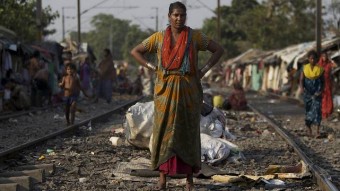Review: Workingman’s Death (2005)

| Category | Reviews |
| Written by | Oliver Stangl |
| Published on | February 24, 2011 |
Summary:
Workingmans’s Death by Austrian director Michael Glawogger won several awards for its impressive depiction of work under extreme circumstances and manages to combine social reportage with artistic imagery. The film, [...]
Workingmans’s Death by Austrian director Michael Glawogger won several awards for its impressive depiction of work under extreme circumstances and manages to combine social reportage with artistic imagery. The film, consisting of five chapters and an epilogue, covers several professions all over the world: miners in the Ukraine (segment „Heroes“), sulphur workers in Indonesia (segment „Ghosts“), butchers in Nigeria („Lions“), welders in Pakistan („Brothers“) and steel workers in China („Future“).
The conditions of the work shown here are hard to believe for the eyes of a western viewer, but, strange as it may seem, watching this film is for the most part not a depressing experience but a sensual one, even in the most „gory“ segment, „Lions“ which shows the butchering of animals in detail. The chapter „Ghosts“, with its depiction of a volcano from which the workers unearth sulphur seems almost surreal. Director of photography Wolfgang Thaler manages to create images – tableaus really – that are simply poetic, though the viewer never forgets how hard every single working day for the men must be. When the camera follows the miners deep down, the viewer doesn’t believe his eyes: The mine is so narrow that the workers only can crawl on their stomachs. It seems extremely hard to get down the working shafts without a camera, but with a camera – virtually impossible. But somehow Thaler did it. On the surface again, the camera shows a huge Lenin statue, once a symbol for a utopian, working class society. But the revolution failed to create a „workingman’s paradise“. Every office worker complaining about his job today will think twice after seeing those scenes.
When the film was released, some critics complained that it doesn’t show economical correlations. But this was not Glawogger’s goal: he simply shows the workers working and lets them talk about their jobs. And this approach works very well – the images speak for themselves. An important film, beautiful and eerie at the same time.
Watch Workingman's Death on documentary.net:












Comments